 |
| Welcome! |
Happy holidays and welcome to another walk in the garden. My northeastern garden is located on the south shore of Long Island in zone 7, although you wouldn't know it with the unusually warm temperatures we have been having for the month of December. With daytime temperatures in the 50's on many days, venturing out into the garden without a winter coat is still a pleasure, so I am taking advantage of the situation while it lasts. It is evident that before long, the true winter temperatures will be here, but for now, come along for a stroll in the garden, and you won't even need to bundle up!
 |
| Front Lawn |
The first stop is along the front island bed that was reinvented just two years ago to include more low maintenance plantings with all season interest. Here is Osmanthus 'Goshiki', a new favorite, along with Weeping Norway Spruce and Mugo Pine with Weeping Japanese Maple in the backdrop.
 |
| Pieris 'Cavatine' (Dwarf Japanese Andromeda) |
On the opposite side of the island bed is Pieris 'Cavatine' or Dwarf Japanese Andromeda, which stays at a compact size of just 2-3 feet tall by wide. I love the little seed pods which can be seen this time of year.
 |
| Driveway Entry |
As the temperatures cool, the bark of Coral Bark Maple (back left) will continue to become a more vibrant pinkish-red as it stands alongside Golden Oriental Spruce 'Skylands' and Weeping Blue Atlas Cedar. A winters snow really does the trick in bringing out the most color!
 |
| Skyland's Spruce Seed Cone |
Here is a close-up view of the seed cones on 'Skylands' Spruce this time of year. They change from a purplish hue to a more golden brown color as the season moves on and add nice interest to the tree.
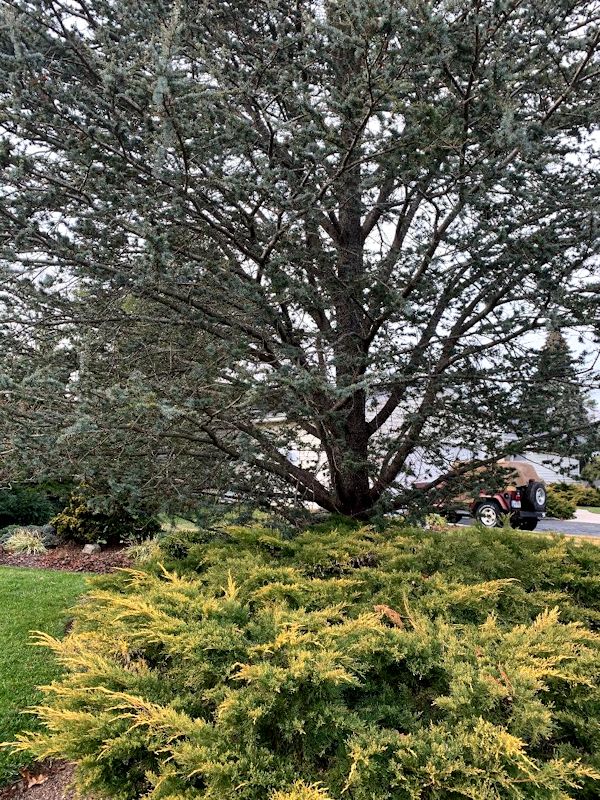 |
| Northern Lawn |
Along the northern lawn is Blue Atlas Cedar with Juniperus 'Gold Lace'. The Blue Atlas Cedar now towers to approximately 40 feet tall.
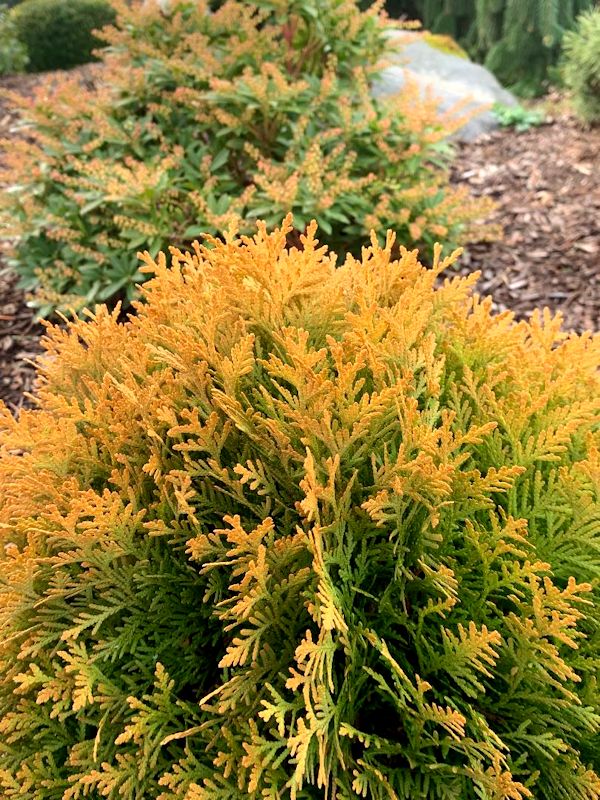 |
| Front Island Berm |
On the front island bed, Anna's Magic Ball Arborvitae (foreground) adds some golden color alongside Dwarf Japanese Andromeda. I enjoy viewing these two shrubs right through winter.
 |
| A Little Whimsy! |
Let's venture to the backyard. Here is one of my favorite statues which reminds me of childhood each time I look at it. Sometimes you just need a little garden whimsy to get you through the day!
 |
| Weeping White Pine Seed Cone |
Along the back pool garden, the seed cones of this Weeping White Pine add a nice touch during every season...
 |
| St. John's Wort |
while St. John's Wort displays its dried fruit this time of year.
 |
| Osmanthus and Golden Sedge |
Did I mention that Osmanthus 'Goshiki' was a new love? Here are more which I planted just this past summer in the back bed, accompanied by Japanese Golden Sedge. With the warmer December temperatures we have been having, it is even sprouting new growth, which varies in color.
 |
| Girard's Azalea Winter Foliage |
Late autumn and wintertime brings some nice foliage changes along with it. Here the foliage of Azalea turns to beautiful hues of deep burgundy and golden-orange.
 |
| More Azalea Winter Foliage |
Here is another view.
 |
| Ajuga 'Black Scallop' |
Wintertime doesn't mean you can't have color. Here is Ajuga 'Black Scallop' with its shiny deep burgundy-black foliage. It will produce bluish-purple blooms in spring.
 |
| Pink Double Knock Out Rose December |
Every autumn and winter I am mesmerized by this Double Knock Out Rose, which yes...still has blooms to brighten the day. Even after some morning frosts, it does not want to quit!
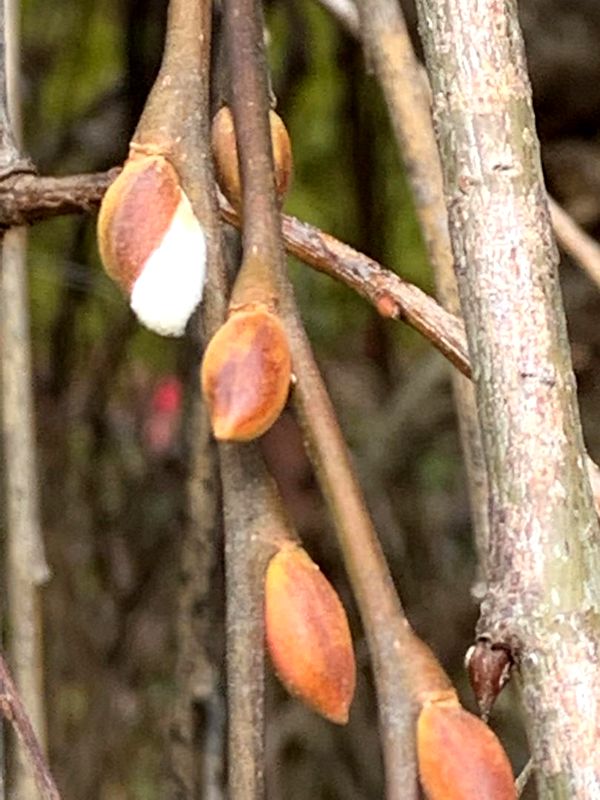 |
| Weeping Pussy Willow December |
Even in December, there are hopes of what is to come, as this Weeping Pussy Willow is already showing its catkins. It is one of the first trees to give interest in early spring.
 |
| Back Pool Garden |
Back around the pool garden is another view of Golden Oriental Spruce along with azalea in winter mode...
 |
| Front Driveway Border |
and by the front driveway is the foliage of Magic Carpet Spirea, which is still hanging on.
 |
| Hellebore 'Shooting Star' December |
You can have blooms in January and here is Helleborous 'Shooting Star', which will do just that. This very plant was the inspiration behind my latest book and I have enjoyed its winter blooms for years. It just makes me smile with every glance, even in the middle of winter.
 |
| Indoor Gardening; Thanksgiving Cactus |
So...while we are awaiting those Hellebore blooms, here are some indoor blooms to enjoy. This is one of the four Thanksgiving cactus I have blooming on my southwestern window sill. I often get asked about what is the difference between Thanksgiving cactus, Christmas cactus, and Easter cactus, and it is in the shape of the leaves. Thanksgiving cactus (Schlumgera truncata) has very pointed, claw shaped projections on the edges of its leaves, Christmas cactus (Schlumgera bridgesti) has more scalloped or tear drop shaped leaves and Easter cactus has more rounded leaves.
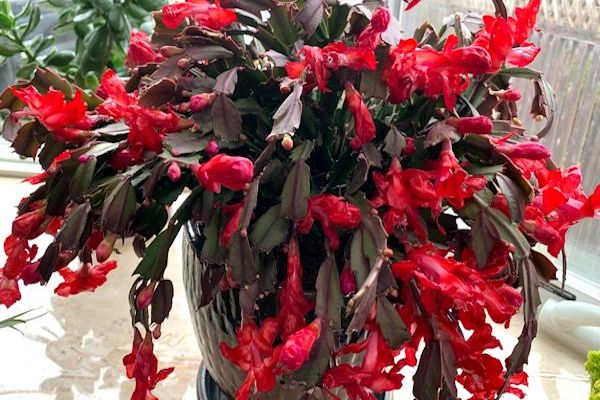 |
| Thanksgiving Cactus |
Here is another variety with deep pinkish-red blooms.
 |
| Peace Lily and Orange Kalanchoe |
A new addition, which I could not resist, is this Kalanchoe and Peace Lily container combination to add some winter blooms to the indoors. As an avid gardener, I consider shopping for plants as part of decorating!
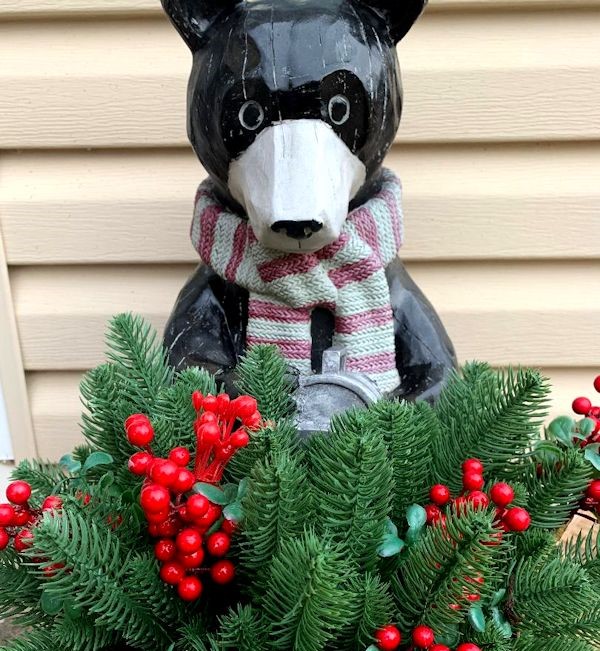 |
| Seasonal Decor |
As the tour comes to an end, I wish for you and your family, a very happy holiday season, Merry Christmas and Happy New Year 2022, filled with good health, happiness, and many fond memories. See you on the 1st. with a garden recap of 2021, start of a brand new gardening year, and new beginnings!
 |
| Thanks for Visiting! |
I hope you enjoyed your visit to my December garden and as always, I look forward to your comments and seeing what's growing in your neck of the woods! Special thanks go out to our hostess Carol at May Dreams Gardens, who makes it possible to see blooms on the 15th of every month with her meme Garden Bloggers' Bloom Day. Also, special thanks to Pam Penick at Digging who has hosted Foliage Follow-Up for all these years, a meme I will still continue to honor. I am also linking with some other wonderful hosts and hostesses at Floral Friday Fotos, Macro Monday 2, Mosaic Monday at Letting Go of the Bay Leaf, Nature Notes at Rambling Woods, Image-in-ing weekly photo share every Tuesday with NC Sue and Gardens Galore Link Up Party every other Monday with Everyday Living. I am also happy to join the Weekly Photo Link-Up at My Corner of the World on Wednesdays and Garden Affair at Jaipur Garden.
A GUIDE TO NORTHEASTERN GARDENING NEWS:
Teaching the garden coaching class at Farmingdale State College on November 23rd. was such a wonderful and rewarding experience and I have been enjoying reading essays from students not only saying how much they enjoyed the presentation, but that they could see themselves going into horticulture! Yes!!!-future horticultural experts to carry on!
To follow A Guide to Northeastern Gardening, and receive updates twice a month on the 1st and 15th, there is a new follow.it subscription widget at the top right side of this page.
Until next time, be well, enjoy the holiday season and “As Always...Happy Gardening”! 😊
Author: Lee @A Guide to Northeastern Gardening,© Copyright 2010-2021. All rights reserved.





























